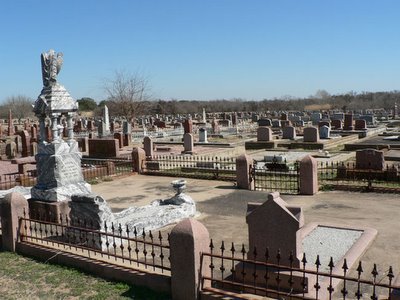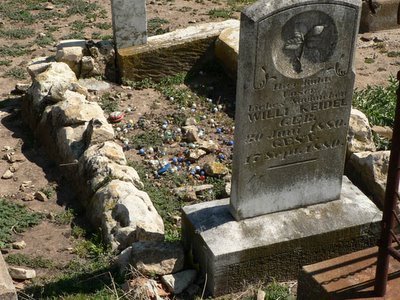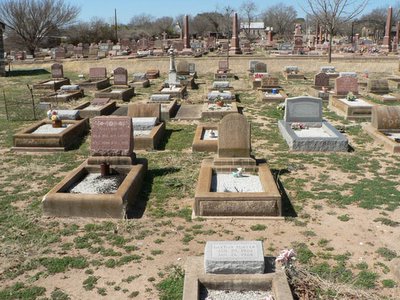I had never seen that before in Texas. I have read of children's graveyards in Ireland and other places in Europe, where unbaptized stillborn infants were buried in unconsecrated sites, but this was new to me.
The Fredericksburg Stadt Friedhof is technically a municipal cemetery, but for practical purposes was for many decades a Lutheran burial ground, because almost everybody in town was one or another kind of Lutheran. There were some German Catholics, who started their own graveyard after 1850, and only a few non-German English-speaking protestants.
Lutherans practice infant baptism, so perhaps unbaptized stillborn infants were buried separately. But this was a city cemetery, so I am not sure how one part of it would end up being "consecrated" and another part unconsecrated. Plus many of the graves were not those of infants who died at birth--some were months old, a few were several years old. It seems very unlikely in a small, pious German Lutheran community, that a two year old child would be unbaptized. It's a mystery.
So, yesterday on the way back from Enchanted Rock, I stopped and took a few photos. The main graveyard, 150 years worth of dead people, seems huge for such a little town, and grim, given the German propensity for orderliness carried to the extent of covering most of the older grave plots entirely with concrete. They did not like grass or weeds growing on graves, and Portland cement is a definitive answer to vegetation. Here's an overview of the cemetery.

I like the practice, now fallen out of favor, of glass mounted photos on tombstones. Here, humanizing these ordered ranks of Town Mountain granite gravemarkers, are two faces looking at us out of the past.
Bertha

Horn player

The children's section is more disorderly, and, to me, more poignant. Maybe it's just the miniature size of the grave plots. I don't know of the photos capture that.
Marbles and a yo-yo left on the grave

The custom of putting shells on graves was common among Central Texas Germans. No one knows where it came from. The practice is not European, and is rare among the Anglo-Texans, who in fact probably got it from the German settlers.

The newer section of children's graves...

...and the older section

The German settlement here was beset by malaria, cholera, and Texans, in order of decreasing morbidity. Malaria and cholera were responsible for many of the older graves here. Texan depredation and outrages against the peaceable German farmers (apparently many of the best Germans came to Texas) reached a peak during the Civil War, when the a large number of the military-age men of the town were slaughtered as they tried to get to Mexico. I don't think they are buried here, though. Texas Germans were pro-Union and anti-slavery, which excited intense hatred among my Texan forebears.
The Fredericksburg colony, unlike any other settlement I know of in Texas, maintained peaceful relations with the Comanches, and did so by the simple tactic making a treaty--with the bands led by chiefs Buffalo Hump and Santa Ana--and then adhering scrupulously to the terms of the treaty. The German settlers lived where they told the Comanches they would live, farmed where they said they would farm, observed boundaries they said they would observe, and allowed the Indians to enter the town unmolested to trade, as they said they would. Indeed, if it had not been for trade with the Comanches a lot more of the immigrants would have died in the two years between their arrival here and the first corn crop they harvested. They also had an agreed-on diplomacy process to iron out problems and misunderstandings. According local mythology it is the only treaty ever reached anywhere with the Indians that was never broken by the white signatories. I don't know if that's true. But the Germans here are proud of it.
In any case, there are no casualties of the Indian Wars buried here, which is not the case with Anglo-Texan cemeteries of a similar age.
No comments:
Post a Comment